| The Abyss - Part V - More Invertebrates |
| Written by Jonathan C. Wojcik - Photo credits unknown or from public news articles unless otherwise noted. If you know their sources and need them credited or removed, please e-mail me. |
| Gastropods |
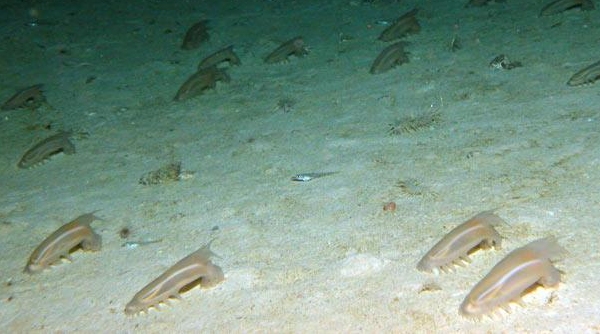
Holothurians or "sea cucumbers" are an especially common sight on the floor of the
abyss, walking on tubular feet and grazing on bacteria-rich sediment with a ring of oral
tentacles. Many sea cucumbers defend themselves from predators by regurgitating their
own sticky intestines, which will quickly regenerate.
abyss, walking on tubular feet and grazing on bacteria-rich sediment with a ring of oral
tentacles. Many sea cucumbers defend themselves from predators by regurgitating their
own sticky intestines, which will quickly regenerate.
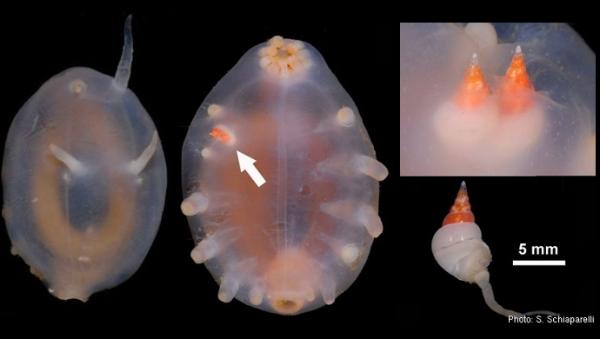
In these images by researcher Stefano Schiapaelli (CAML), we can get a good look
at a Scotoplane or "sea pig" and a newly discovered species of parasitic snail.
at a Scotoplane or "sea pig" and a newly discovered species of parasitic snail.
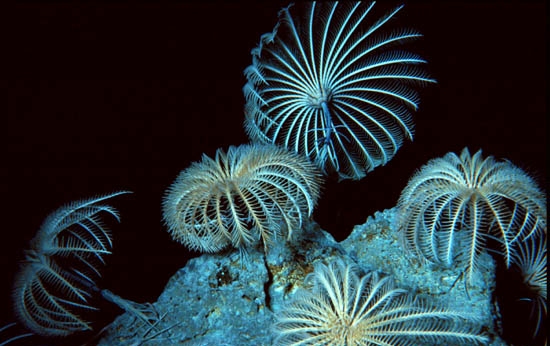
Stalked, filter-feeding Crinoids or "sea lilies" were once abundant at all aquatic
depths, but have been largely restricted to the abyss for millions of years. Some
species are able to detach and swim short distances, or even walk on two or more
tentacles in a bizarrely anthropomorphic fashion.
depths, but have been largely restricted to the abyss for millions of years. Some
species are able to detach and swim short distances, or even walk on two or more
tentacles in a bizarrely anthropomorphic fashion.
Marine slugs and snails typically spend their early days as free-swimming, planktonic
larva before settling down to a life of sluggish slithering. Some groups, however, are
holoplanktonic, which means that they retain their swimming form throughout their
lifespan. These gelatinous, flapping "sea butterflies" or "pteropods" may filter-feed
on microscopic plankton, trap food in dangling webs of mucus or actively hunt other
invertebrates. Their shells can be external, internal or completely absent, and some
may display bioluminescence. Holoplanktonic mollusks are found throughout our
oceans, but seem to be more common in much colder waters.
larva before settling down to a life of sluggish slithering. Some groups, however, are
holoplanktonic, which means that they retain their swimming form throughout their
lifespan. These gelatinous, flapping "sea butterflies" or "pteropods" may filter-feed
on microscopic plankton, trap food in dangling webs of mucus or actively hunt other
invertebrates. Their shells can be external, internal or completely absent, and some
may display bioluminescence. Holoplanktonic mollusks are found throughout our
oceans, but seem to be more common in much colder waters.
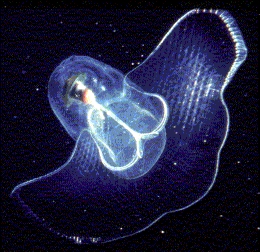
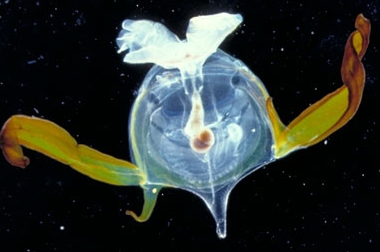
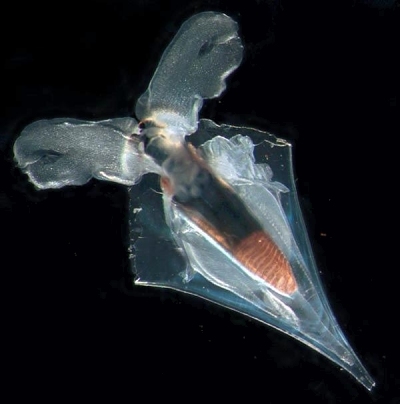
| Sponges |
| Xenophyophores |
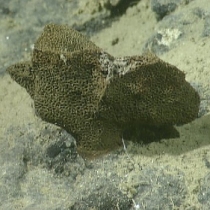
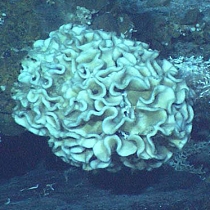
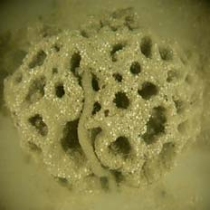
I can't remember when it was that I first learned of these humble little creatures, but
I've yet to fully overcome the shock of their existence, and by now, I'm sure you know
that this is saying quite a bit. Liesurely creeping along the muck of the sea floor,
these gelatinous globules collect tiny fragments of shells, sponges and other animal
remains to build a hollow casing or "test" (what we see in these photos) around their
delicate bodies. Different species favor different building materials, and many form
tests of their own hardened excrement. They secrete a blanket of mucus as they sift
for tiny particles of food in the surrounding mud, engulfing it in one more amorphous
pseudopodia.
So, where's the shocking part? With some species reaching the size of a human fist,
Xenophyophores are, by an immense margin, the world's largest single-celled
organisms. They are protozoans, related to the amoeba.
Giant germs that wear their feces are as high a note as I could ever end on, so with
that, I'll bring this crappy little e-tour to a close. Every year, science is surprised anew
by what we dredge up from these stygian pits, and we can no doubt look forward to
ever-weirder zoological discoveries in our lifetimes.
I've yet to fully overcome the shock of their existence, and by now, I'm sure you know
that this is saying quite a bit. Liesurely creeping along the muck of the sea floor,
these gelatinous globules collect tiny fragments of shells, sponges and other animal
remains to build a hollow casing or "test" (what we see in these photos) around their
delicate bodies. Different species favor different building materials, and many form
tests of their own hardened excrement. They secrete a blanket of mucus as they sift
for tiny particles of food in the surrounding mud, engulfing it in one more amorphous
pseudopodia.
So, where's the shocking part? With some species reaching the size of a human fist,
Xenophyophores are, by an immense margin, the world's largest single-celled
organisms. They are protozoans, related to the amoeba.
Giant germs that wear their feces are as high a note as I could ever end on, so with
that, I'll bring this crappy little e-tour to a close. Every year, science is surprised anew
by what we dredge up from these stygian pits, and we can no doubt look forward to
ever-weirder zoological discoveries in our lifetimes.
| Echinodermata |
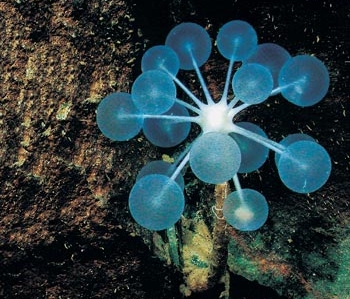
A flesh-eating beast you are unlikely to find in a pineapple, the surface of this innocuous-looking
deep-sea organism functions as a sort of flypaper for small crustaceans, entangling their jointed
limbs in a velcro-like pattern of microscopic hooks. Special cells in the sponge's body migrate
around the prey to form a temporary orifice, where its lipid content is absorbed and carried to
the sponge's core.
Many other sponges feed in a similar fashion, but Chondrochladia lampadiglobus, pictured here,
is one of the most visually striking. Nearly all are found in the deep-sea abyss, arctic waters and
underwater caves where sunlight and plankton are relatively scarce.
deep-sea organism functions as a sort of flypaper for small crustaceans, entangling their jointed
limbs in a velcro-like pattern of microscopic hooks. Special cells in the sponge's body migrate
around the prey to form a temporary orifice, where its lipid content is absorbed and carried to
the sponge's core.
Many other sponges feed in a similar fashion, but Chondrochladia lampadiglobus, pictured here,
is one of the most visually striking. Nearly all are found in the deep-sea abyss, arctic waters and
underwater caves where sunlight and plankton are relatively scarce.
| Photo by MBARI |